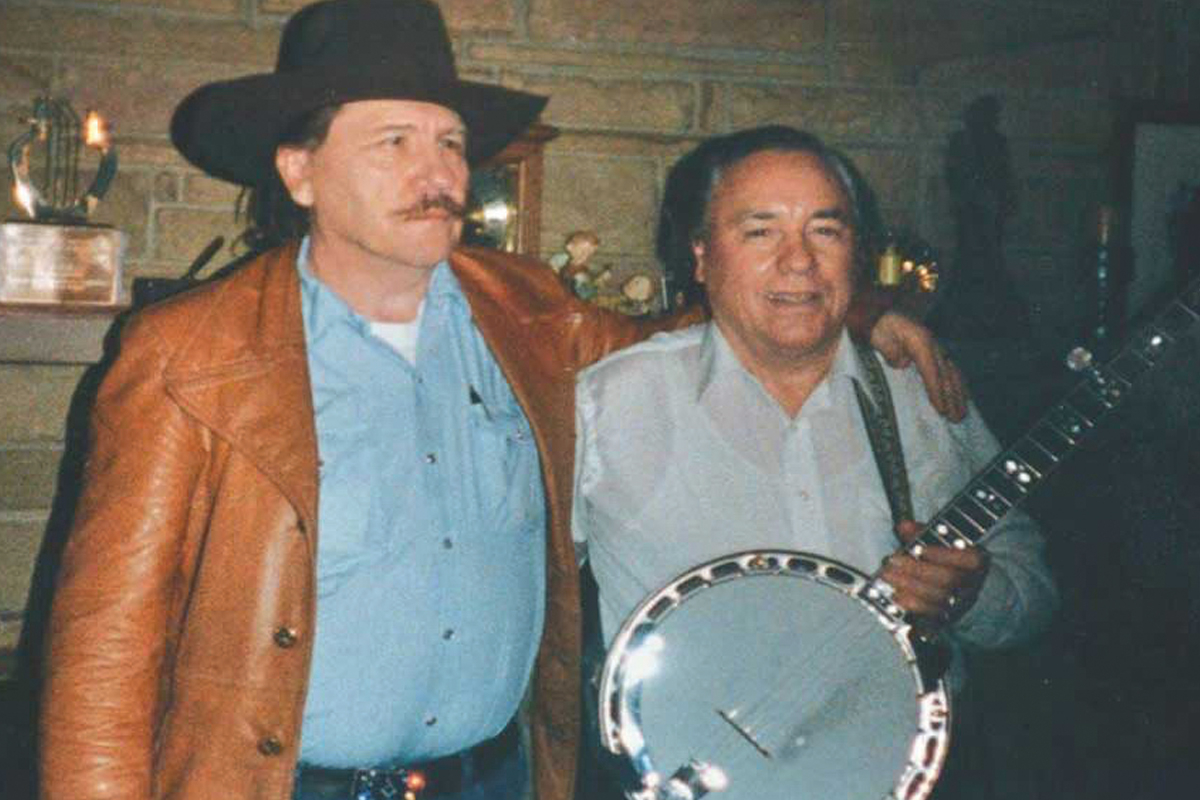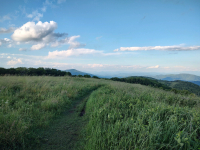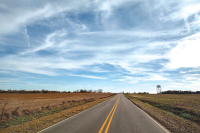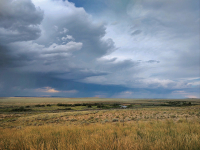Fingers like lightning: A Haywood County banjo retrospective
 Raymond Fairchild and Earl Scruggs. File photo
Raymond Fairchild and Earl Scruggs. File photo
Editor’s Note: Since first rolling into Haywood County in August 2012 to start work as the arts and entertainment editor for The Smoky Mountain News, Garret K. Woodward has been extensively documenting banjo players around our backyard.
The following are excerpts from previously published SMN features on a handful of five-string wizards.
Play me that mountain music: Carroll Best and The White Oak String Band (08/27/2014)
French Kirkpatrick can sum up Carroll Best.
“What he did with the banjo was above and beyond,” Kirkpatrick said. “He was the most, probably without a doubt, the most creative banjo player I was ever in a room with.”

Carroll Best was a legendary Haywood County banjo player.
Recently at his home in Ironduff, a mountain community a few miles outside of Waynesville, Kirkpatrick, an acclaimed musician in his own right, relaxed further back into his couch and reminisced with a smile about his late friend.
Related Items
“When you hear somebody put a string of notes together that just keeps rolling, and he just keeps rolling — it was amazing,” the 75-year-old said. “[Carroll] was not restricted to one style of music. It was phenomenal what he did on a banjo.”
Regarded as one of the all-time great and influential banjoists, Best, a Haywood County native, was known for his signature “fiddle style,” which was a melodic, syncopated three-finger stroke he evolved and perfected. That specific style of playing allowed Best the capability to perform a wide-array of songs by following fiddle tunes note for note.
“Carroll was a gifted, regional banjo player who influenced national musicians. He was among the first, if not the very first banjo player to move three-finger hillbilly ‘pickin’ toward jazz and melodic melodies requiring a sophisticated ear and independent dexterity given only to few,” said Marc Pruett, Grammy Award-winning banjoist of Balsam Range and Haywood County native. “He farmed, he worked in the local mill for years, and to those of us lucky enough to have known him, he freely shared his music.”

French Kirkpatrick and Carroll Best.
And that unique sound echoing from Best’s fingertips was captured on a reel-to-reel tape by storied “song catcher” Joseph S. Hall. During two recording sessions in 1956 and 1959, Hall gathered a handful of Haywood pickers, including Best and Kirkpatrick, to sit around a living room and simply play the melodies they knew and loved.
Some of the recordings were kept in Hall’s personal and extensive archives, while others were sent directly to the Library of Congress in Washington, D.C., for posterity and as a historical record of Southern Appalachian culture.
Those tapes were recently dusted off by Dr. Ted Olson, professor of Appalachian studies at Eastern Tennessee State University in Johnson City, Tenn. Alongside the Great Smoky Mountains Association, a nonprofit preserving the culture of Southern Appalachia, Olson has now released a 37-song collection of the Hall recordings with the album “Carroll Best and The White Oak String Band, Old-Time Bluegrass from the Great Smoky Mountains, 1956 and 1959.”
“When people look back at what was happening [with these recordings], they will see a major link between the [old-time] Appalachian music and how it ties into the bluegrass music that came out of Kentucky,” Kirkpatrick said. “These guys were not copying Earl Scruggs or Don Reno’s versions, these guys wanted to make their own sound.”
This must be the place: Ode to Steve Sutton — banjo legend, dear friend (05/17/2017)
With the sudden death of legendary Haywood County banjoist Steve Sutton on Saturday, the region — and the world — has lost one of the great pickers and torchbearers of bluegrass and mountain music. A longtime member of the Darren Nicholson Band and Whitewater Bluegrass Company, Sutton was 60 years old when he passed away in his sleep on May 13, one day shy of his 61st birthday.

Darren Nicholson and Steve Sutton.
“I basically owe my musical career to him,” said mandolinist Darren Nicholson of IBMA “Entertainer of the Year” bluegrass act Balsam Range, who was Sutton’s best friend and longtime collaborator. “He got me my first professional job, which led to all the relationships that are still relevant in my current career. Steve believed in me so much that he took me to Strains of Music in Waynesville and paid cash for a Gibson mandolin. We never looked back and went so many miles all over the United States and around the world.”
A Grammy-nominated, multiple IBMA award-winner himself, Sutton graduated from Tuscola High School in Waynesville. Upon graduation, he was simultaneously offered gigs with the “Godfather of Bluegrass” Bill Monroe and bluegrass legend Jimmy Martin.
“But, Jimmy offered me something like $10 more a week, so I took it,” Sutton chuckled in a 2015 interview with The Smoky Mountain News.
In 1974, Sutton joined Martin on the road, kicking off a career that took him across the globe, ultimately gracing the Grand Ole Opry stage numerous times. Sutton also had stints with Alecia Nugent and Rhonda Vincent. And through his lifelong pursuit of bluegrass and mountain music, Sutton also remembered where it all began, alongside banjo great and Bluegrass Hall of Famer Raymond Fairchild.
Sutton was in awe of Fairchild’s intricate playing. He’d never seen something like that, and immediately wanted to be up there, onstage, doing the same thing.
“I was over there at the Hillbilly Funhouse [in Maggie Valley] playing alongside Raymond, learning everything I could from him, watching everything he did,” Sutton said.
In an effort to maybe get a few extra tips from passerby tourists, Fairchild would pass off Sutton as his son onstage, saying the folks in the crowd (Sutton’s parents) were kind enough to watch him for Fairchild when he was up there trying make money “to pay the electric bill.”
“And if we drew a crowd, we’d pass the hat around and it’d fill up with tips,” Sutton said. “And Raymond would always give me all the money in the hat, which is what I saved up and used to buy my first real nice banjo a couple years later.”

Jeff Smith and Steve Sutton.
“As a banjo player and guitar player, Steve was different because of his versatility and love for all kinds of music,” Nicholson noted. “He took anyone or band he played with to another level because of this. He was innovative and truly a virtuoso. He was unparalleled from the standpoint that he literally could play any song or style of music — he was a crown jewel of our mountain music.”
“[Steve’s] talent and free-flowing sense of humor constantly fed that professional effort to the highest levels,” added Marc Pruett. “Steve was a valued, respected member of a heritage-schooled, living culture. He was ‘the real deal,’ and his warm smile and larger-than-life talent leaves a void in our mountains that can’t be filled.”

Marc Pruett Band.
Can’t keep a good man down: Banjo legend Raymond Fairchild on turning 80, a life in music (06/06/2019)
Though his fingers seemingly wrap around a walking cane more than his trusty banjo these days, Raymond Fairchild remains one of the finest musicians who ever picked up the five-string acoustic instrument — alive or six feet under.
“I just count myself another mountain picker. I don’t think I’m no better than anybody else, but I think I’m as good as any of’em — that’s the legacy,” Fairchild said with his trademark grin. “When they ask me when I’m going to retire, I say when somebody comes along and beats me at picking the banjo — and they said, ‘you’ll never retire.’”

Raymond Fairchild at the Maggie Valley Opry House.
Fairchild is sitting in a chair in front of the Maggie Valley Opry House, which he and his wife Shirley have owned and operated for 33 years. Fairchild himself recently turned 80, but shows no signs of slowing down, even with a performance schedule at the Opry House that hovers around seven nights a week in the summer months.
“The Opry House is a like a second home. I’ve about quit the road and that gives people a chance to come see me here, you know? Travel will kill you, man,” Fairchild said. “I play Friday and Saturday up to Memorial Day. Then, I’m going to play seven nights a week when I can. See, I’m going to run the Opry House — it ain’t going to run me.”

Raymond Fairchild with Bill Monroe and Ralph Stanley
If you’re unaware of who Raymond Fairchild is, you might be unaware that he’s regarded as one of the three all-time great banjoists in the history of bluegrass and mountain music, the other two being the late Earl Scruggs and the late Don Reno — a statement of merit made to Fairchild by the “Father of Bluegrass” himself, the late Bill Monroe.
“Bill Monroe told me that. Earl Scruggs told me that, too,” Fairchild smiled. “And when you say bluegrass, it’s Bill Monroe — the rest after Bill Monroe are just copycats. Bill Monroe was the true bluegrass man, and he’ll never be equaled — you don’t beat a man at his own game.”

Raymon Fairchild playing for a black bear.
Aside from the unique dexterity in Fairchild’s fingertips, what’s just as awe-inspiring is the lightning-fast speed by which he plays such intricate and complicated melodies.
“It just comes from the way I learned, I guess — I always liked to play fast. Of course, I can’t play that fast now,” Fairchild modestly stated. “And another thing, it all depends on who’s behind you. If the backup men can’t get it, you can’t either — they’ll drag you down.”
Gazing along the walls of the aging Opry House, there are numerous awards, including plaques signifying over two million records sold of Fairchild’s instrumental “Whoa Mule,” now a standard of traditional music. Right next to the stage, there’s also his award for induction into Bill Monroe’s Bluegrass Hall of Fame (Bean Blossom, Indiana), an honor he received in 2015.

Raymond Fairchild at the Hillbilly Funhouse.
Within the 65 years he’s played professionally, one moment sticks out more than the rest — the first time Fairchild took the stage at the Grand Ole Opry, held at the Ryman Auditorium in Nashville, Tennessee. Fairchild reckons that initial appearance was somewhere around 1977 or 1978. No matter though, because it led to several other pickin’-n-grinnin’ sessions onstage at “The Mother Church of Country Music.”
“A lot of people say their knees are shaking and they were nervous [being onstage at the Grand Ole Opry]. It didn’t bother me more than stepping out here [at the Maggie Valley Opry House],” Fairchild reminisced. “But, I knew it was the highest you were going to go in this type of music — when you stand in front of them WSM microphones.”

















